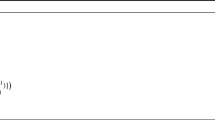Abstract
The construction of optimal designs for change-over experiments requires consideration of the two component treatment designs: one for the direct treatments and the other for the residual (carry-over) treatments. A multi-objective approach is introduced using simulated annealing, which simultaneously optimises each of the component treatment designs to produce a set of dominant designs in one run of the algorithm. The algorithm is used to demonstrate that a wide variety of change-over designs can be generated quickly on a desk top computer. These are generally better than those previously recorded in the literature.
Similar content being viewed by others
References
Aarts, E. H. L. and Laarhoven, P. J. M. (1989) Simulated an-nealing: An introduction, Stastistica Neerlandica, 43(1), 31-52.
Chankong, V. and Haimes, Y. Y. (1983) Multiobjective Decision Making: theory and methodology, North Holland (NY).
Cheng, C. S. and Wu, C. G. (1980) Balanced repeated measure-ments designs, Ann. Statist., 8, 1272-83.
Eccleston, J. A. and Street, D.J. (1994) An algorithm for the construction of optimal or near-optimal change-over designs, Austral. J. Statist., 36, 371-78.
Haimes, Y. Y., Wismer, D. A. and Lasdon, L. S. (1971) On bicriterion formulation of the integrated systems identifica-tion and system optimization, IEEE Transactions on Systems, Man. and Cybernetics SMC-1, 296-97.
John, J. A. and Whitaker, D. (1993) Construction of resolvale row-column designs using simulated annealing, Austral. J. Statist., 35(2), 237-45.
Kunert, J. (1983) Optimal design and refinement of the linear model with applications to repeated measurements designs, Ann. Statist., 11, 247-57.
Kunert, J. (1984) Optimality of balanced uniform repeated mea-surements designs, Ann. Statist., 12, 1006-17.
Iqbal, I. and Jones, B. (1994) Efficient repeated measurements de-signs, Journal of Statistical Planning and Inference, 42, 79-88.
Matthews, J. N. S. (1988) Recent developments in crossover de-signs, Internat. Statist. Rev., 56, 117-27.
Mead, R. (1992) The design of experiments. Statistical Principles for Practical Applications, Cambridge University Press, Cambridge UK.
Metropolis, N., Rosenbluth, A. W., Rosenbluth, M. N., Teller, A. H. and Teller, E. (1953) Equation of state calculation by fast computing machines, J. Chem. Physics, 21, 1087-91.
Pareto, V. (1906) Manuale di economia politica, con una int-roduzione ulla scienza sociale, Societa Editrice Libraria, Mi-lan, Italy.
Russell, K. G. (1991) The construction of good change-over de-signs when there are fewer units than treatments, Biometrika, 78, 305-13.
Street, D. J. (1989) Combinatorial problems in repeated mea-surement designs, Discrete Math., 77, 323-43.
Street, D. J., Eccleston, J. A. and Wilson, W. H. (1990) Tables of small optimal repeated measurements designs, Austral. J. Statist., 35, 345-60.
Whitaker, D. (1995) A Nested Simulated Annealing Algorithm, J. Statist. Comput. Simul., 53, 233-41.
Williams, E. R. and John, J. A. (1989) Construction of Row and Column Designs with Contiguous Replicates, Appl. Statist., 38, 1, 149-54.
Zeleny, M. (1976) Multiple Criteria Decision Making, Springer-Verlag (NY).
Rights and permissions
About this article
Cite this article
Eccleston, J., Whitaker, D. On the design of optimal change-over experiments through multi-objective simulated annealing. Statistics and Computing 9, 37–42 (1999). https://doi.org/10.1023/A:1008810109585
Issue Date:
DOI: https://doi.org/10.1023/A:1008810109585




